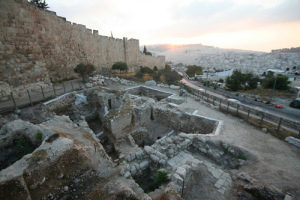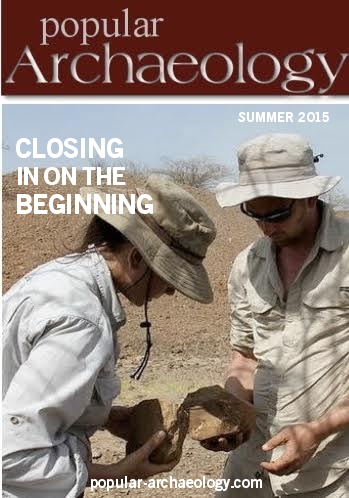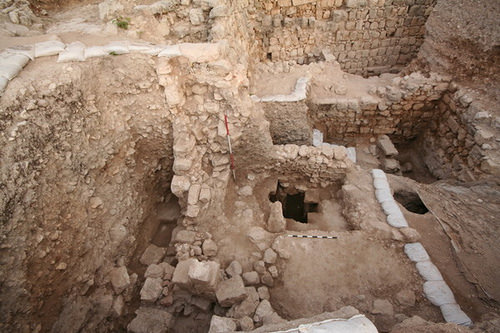
Palatial ancient homes with basements with vaulted ceilings, countless pottery fragments, other artifacts left in place since deposited as much as 2,000 or more years ago—these are the kinds of things that a team of archaeologists, students and volunteers with the Mount Zion excavations project have been digging up just below the historic walls of Jerusalem, the city sacred to three of the world’s great religions.
Led by Shimon Gibson, a British-born Israeli archaeologist, who is also adjunct professor at the University of North Carolina at Charlotte (UNC Charlotte) and Senior Associate Fellow at the W. F. Albright Institute of Archaeological Research, along with James Tabor, a well-known scholar of early Christianity and Professor in the Department of Religious Studies, also at UNC Charlotte, the team has recently completed its 2015 season of excavations, building on the large collection of finds and records they have already amassed from previous seasons—findings that are helping them to gradually piece together what life was like for the people who lived here centuries before in the shadow of Jerusalem’s ancient walls.
“We’re uncovering ancient Jerusalem in all of its periods,” says Tabor in a recently made news documentary about the dig. “This is actually the center of the city” he says about the location of the dig. That’s because the historic 15th-16th century Old City wall that overlooks the site did not exist for most of the time periods represented by the finds his team are uncovering. “So you have to imagine markets and houses and streets, and those are not visible now. It’s like a city arising out of the soil.”*
Says Gibson: “The early remains that we thought were badly preserved turned out to be extremely well preserved, with houses, palatial houses dating back 2,000 years, with the ceilings of the lower basement levels intact, vaulted ceilings, and doorways leading into different chambers.”*
Some of the finds made in previous seasons include a plastered cistern, a stepped and plastered ritual bathing pool (‘mikveh’) with a well preserved barrel-vaulted ceiling, a chamber containing three bread ovens (‘tabuns’), Early Roman pottery, lamps, stone vessels, murex shells, coins, Roman Tenth Legion stamped roof tiles, and what appeared to be a relatively rare and well-preserved, plastered bathtub. Gibson and Tabor suggest that what they are finding could be a wealthy neighborhood and, given the site’s proximity to the location of the Herodian-built Second Temple known from the time of Jesus, possibly a community that included priests who served at the Temple.
Gibson hopes that, beyond the scientific and scholarly gain that will be generated by the excavations and research, the work here will set the stage for an archaeological park open to the public. “With time,” he adds, “when we have completed the excavation work, we will be getting down to preserving the archaeological remains and then opening it up as a park so that one day these people that are now passing by in bewilderment looking at our tents and seeing all this fuss being made in these excavation trenches will be able to come down and pass through and see all of these amazing remains in a way which together combine into a kind of theatre of history.”*
_____________________________________
Above: The Mount Zion dig site. Courtesy Shimon Gibson and the Mount Zion Excavations Project.
_________________________________________
Looking down into the area of the basement of a Herodian period house. Courtesy Shimon Gibson and the Mount Zion Excavation Project.
______________________________________
Tabor envisions a close and developing connection between the project, Jerusalem and UNC Charlotte and the Charlotte community, building a bridge between two locations thousands of miles apart, physically separated by geography and different cultures, but joined by their common humanity.
“We want the University to have an impact on the community,” said Tabor, “and this is one of the ways—a UNC Charlotte connection, but also for the city of Charlotte. This is our Charlotte pride here. What other city has a dig in Jerusalem?”*
UNC Charlotte is the only non-Israeli school with a license to dig in Jerusalem.
__________________________________________________
__________________________________________________
A detailed feature article about the Mount Zion dig was published in the December, 2013 issue of Popular Archaeology Magazine and can be accessed here.
__________________________________________________
*News video documentary: UNV Charlotte in Jerusalem/NC Now/UNC-TV
__________________________________________________
 Read more in-depth articles about archaeology with a premium subscription to Popular Archaeology Magazine.
Read more in-depth articles about archaeology with a premium subscription to Popular Archaeology Magazine.
In addition, the latest Popular Archaeology ebook is now available.
______________________________________________
Travel and learn with Far Horizons.
____________________________________________
 This richly illustrated ebook version of a recent Popular Archaeology issue includes the following stories: The discovery of the tomb of a previously unknown pharaoh that is shedding light on a lost ancient Egyptian dynasty; how genetics is revolutionizing what we know about human evolution and our prehistoric past; one scholar’s controversial ‘New Chronology’ and how it supports the historicity of the biblical Exodus; how archaeologists are unearthing new history in Williamsburg, Virginia, a seat of British colonial power in 18th century America; the discovery of the remains of a major Roman legionary base in Israel; the unearthing of an ancient Judean fortified settlement in the borderlands between the biblical kingdoms of ancient Judah and the Philistines; and how archaeologists are uncovering evidence of what may have been an important administrative center of Judah during the 8th century BCE. Now available from Amazon.com!
This richly illustrated ebook version of a recent Popular Archaeology issue includes the following stories: The discovery of the tomb of a previously unknown pharaoh that is shedding light on a lost ancient Egyptian dynasty; how genetics is revolutionizing what we know about human evolution and our prehistoric past; one scholar’s controversial ‘New Chronology’ and how it supports the historicity of the biblical Exodus; how archaeologists are unearthing new history in Williamsburg, Virginia, a seat of British colonial power in 18th century America; the discovery of the remains of a major Roman legionary base in Israel; the unearthing of an ancient Judean fortified settlement in the borderlands between the biblical kingdoms of ancient Judah and the Philistines; and how archaeologists are uncovering evidence of what may have been an important administrative center of Judah during the 8th century BCE. Now available from Amazon.com!
____________________________________________







